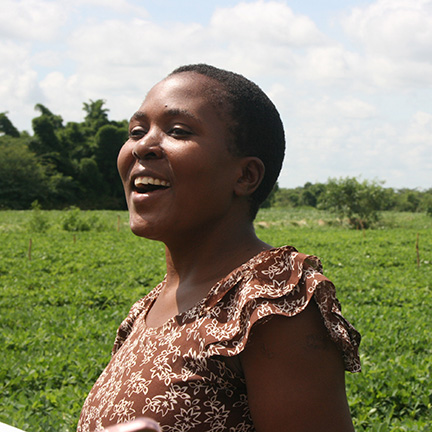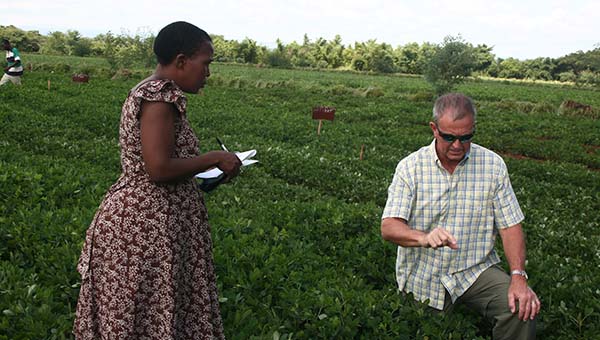Extension agent uses her master's research to answer farmers' questions
By Allison Floyd
University of Georgia, Peanut & Mycotoxin Innovation Lab
Lydia Mkandawire is a farmer and a teacher and a scientist.
Those occupations come together in her work as an agricultural extension agent, but a few years ago she realized she didn’t always know what advice was best for the farmers in her region of central Malawi. So, she decided to return to school for a master’s degree, and find the answers she needed.
“My job is to disseminate the agricultural technologies or new research findings to farmers so that farmers improve their agricultural productivity,” she said. “I found myself to have a gap in most agricultural technologies. This is what motivated me to go for a higher degree.”
Over the past two years, with support from the Peanut & Mycotoxin Innovation Lab, Mkandawire has completed coursework for a master’s degree at Lilongwe University of Agriculture and Natural Resources, while performing peanut field trials on farms owned by Exagris, a commercial seed producer in Malawi.

Lydia Mkandawire researched several variables, including planting date and density, while working on a master's degree at Lilongwe University of Agriculture and Natural Resources. In a new partnership with the commercial seed company, Exagris, Mkandawire worked on company farms, giving her bigger plots and diverse agroecologies. (Photo by Allison Floyd)
“My research has different variables, but the main question was about plant density. What I have found surprising is that yield increased as plant population increased,” she said. Mkandawire expected that as the plant population increased, the stand would choke itself, curtailing production.
“I was thinking that crops may be competing for above- and below-ground resources, but this was not the case in 2016 results,” she said. Testing populations of 89,000 plants per hectare; 178,000 plants per hectare; and 285,000 plants per hectare, Mkandwire found that yield increased steadily with higher planting density at two research locations in different agroecological zones.
Her highest yield that year was 1,289 kg/ha at a farm in the low-lying eastern area near Lake Malawi.
Farmers in her country usually plant at low density, but knowing that they will find a return on the investment, farmers might choose to buy more seed and plant a denser stand of peanuts.
They might also reconsider when they plant, Mkandawire suggests. Studying planting date, she found that groundnut planted early, before the start of the rainy season had 10 to 20 percent higher yield than groundnut planted later.
“Here in Malawi, it’s a common practice that farmers plant groundnut after they have planted other crops like maize and tobacco, and after the rains have come. Priority for planting goes first to cash crops and other food crops, but with such practices farmers miss good yields for the groundnut crop,” she said.
She also tested for aflatoxin contamination and found that on-time harvest makes a difference.
“Aflatoxin also was not found in the groundnut that was harvested early and at physiological maturity across the plant densities. This means that farmers have to grow on high plant density and harvest at close to or at physiological maturity,” she said.
A second year of data has confirmed the 2016 findings.
Mkandawire is the first LUANAR student to do research on Exagris’ farms, working alongside the company’s commercial seed production and research fields. She is advised by North Carolina State University entomologist Rick Brandenburg, the lead scientist on the PMIL value chain project in Southern Africa.
“Working with Exagris assisted me a lot because they have good land where you can do research on big plots,” she said. “This reduces variation, as you know that soils are not homogenous.
“Exagris is also doing its farming research, so there was a good collaboration. Everyone was interested to see the results and how my work will impact groundnut yields and reduce aflatoxin,” she said.
Now, Mkandawire is thinking of practical applications for the farmers in her area.
“The questions that I have remaining involve whether the high plant density works for smallholder farmers,” she said. “Groundnut does well in different zones, but will the technologies used in my research bring similar results in other zones? When I know that, I can create some recommendations.”
While she would like to continue the research, Mkandawire is on unpaid leave from her extension job and must return to that work in spring.
“If I have an opportunity to continue studying on the gaps, it would be good. But while waiting for such an opportunity, I will be working,” she said.
Women are responsible for much of the farming in Malawi – particularly peanut production – but aren’t as likely to study agricultural science as men are.
“More women go for food science than agronomy, but my background motivated me to do agronomy,” said Mkandawire, who grows groundnuts, as well as maize, soybeans and cowpeas on her farm.
She wants to have more data to show that high planting density is advisable in other areas, but the results from two years’ trials at two locations convinced her to change some of her own practices.
“I grew some groundnuts on my 10 hectares using the highest plant density I explored in my research, and the yields are higher than at the lowest plant density,” she said. “I like farming, and always want to know how I can grow crops for profit maximization.”
--Published July 31, 2017
